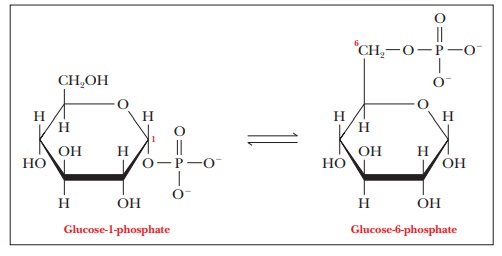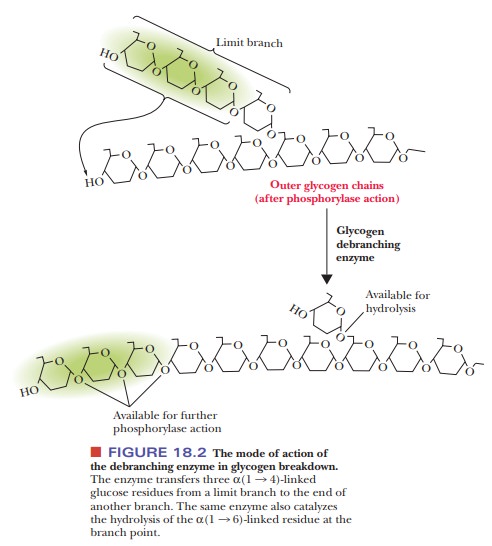Chapter: Biochemistry: Storage Mechanisms and Control in Carbohydrate Metabolism
How does the breakdown of glycogen take place?
How does the breakdown of
glycogen take place?
Glycogen is found primarily in liver and muscle. The release of
glycogen stored in the liver is triggered by low levels of glucose in blood.
Liver glycogen breaks down to glucose-6-phosphate, which is hydrolyzed to give
glucose. The release of glucose from the liver by this breakdown of glycogen
replenishes the supply of glucose in the blood. In muscle, glucose-6-phosphate
obtained from glycogen breakdown enters the glycolytic pathway directly rather
than being hydrolyzed to glucose and then exported to the bloodstream.
Three reactions play roles in the conversion of glycogen to glucose-6-phosphate. In the first reaction, each glucose residue cleaved from glycogen reacts with phosphate to give glucose-1-phosphate. Note particularly that this cleavage reaction is one of phosphorolysis rather than hydrolysis.

In a second reaction, glucose-1-phosphate isomerizes to give glucose-6-phosphate.

Complete breakdown of glycogen also requires a debranching reaction
to hydrolyze the glycosidic bonds of the glucose residues at branch points in
the glycogen structure. The enzyme that catalyzes the first of these reactions
is glycogen phosphorylase; the
second reaction is catalyzed by phosphoglucomutase.
Glycogen phosphorylase
Glycogen + Pi OO3 =>
Glucose-1-phosphate + Remainder of glycogen
Phosphoglucomutase
Glucose-1-phosphate =>
Glucose-6-phosphate

Glycogen phosphorylase cleaves the α(1 - > 4) linkages in glycogen. Complete
breakdown requires debranching enzymes
that degrade the α(1 -
> 6) linkages. Note that no ATP is hydrolyzed in the first reaction. In the
glycolytic pathway, we saw another example of phosphorylation of a substrate
directly by phosphate without involvement of ATP: the phosphorylation of
glyceraldehyde-3-phosphate to 1,3-bisphosphoglycerate.
This is an alternative mode of entry to the glycolytic pathway that “saves” one
molecule of ATP for each molecule of glucose because it bypasses the first step
in glycolysis. When glycogen rather than glucose is the starting material for
glycolysis, there is a net gain of three ATP molecules for each glucose
monomer, rather than two ATP molecules, as when glucose itself is the starting
point. Thus, glycogen is a more effective energy source than glucose. Of
course, there is no “free lunch” in biochemistry and, as we shall see, it takes
energy to put the glucoses together into glycogen.
The debranching of glycogen involves the transfer of a “limit branch” of three glucose residues to the end of another branch, where they are subse-quently removed by glycogen phosphorylase. The same glycogen debranching enzyme then hydrolyzes the α(1 - > 6) glycosidic bond of the last glucose residue remaining at the branch point (Figure 18.2).

When an organism needs energy quickly, glycogen breakdown is important. Muscle tissue can mobilize glycogen more easily than fat and can do so anaerobically. With low-intensity exercise, such as jogging or long-distance running, fat is the preferred fuel, but as the intensity increases, muscle and liver glycogen becomes more important. Some athletes, particularly middle-distance run-ners and cyclists, try to build up their glycogen reserves before a race by eating large amounts of carbohydrates.
Related Topics